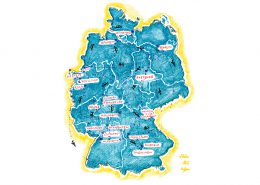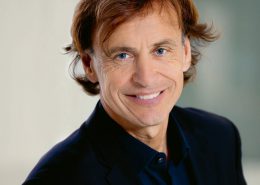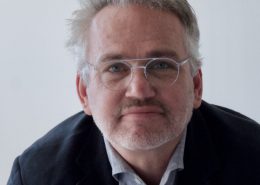Focusing on the Consumer
adidas’ Executive Board Member Global Brands (CMO) Eric Liedtke is putting the spotlight back on customer needs. His marketing strategy has not only proved extremely successful, but also won him the “CMO of the Year” award in 2017.
When Eric Liedtke succeeded company veteran Erich Stamminger as Executive Board Member of Global Brands at Adidas AG in March 2014, the company was reporting a shareholder profit of 839 million euros. Although the figures were good from the shareholders’ point of view, industry insiders saw the group as being insufficiently prepared for the future and lagging behind its competitors, Nike included. The brand’s performance in the USA, the biggest sports market in the world, was also a cause for concern: here the newcomer Under Armour had pushed the German company down to third place.
Enter Eric Liedtke, who CEO Herbert Hainer wanted to “take on more responsibility for the future of our company”. “I want to stir up the way we think and question our previous way of working,” said the former American football player, rising to the challenge. He had been working at the company for 20 years in 2006 when he made the move from the US headquarters in Portland to the parent company in Herzogenaurach in the south of Germany. “We were very much organised into functions and the consumer wasn’t at the focus of our organisational structure,” he now admits.
As part of this new focus onto the needs of the consumers, Liedtke restructured the organisation into sporting disciplines and completely removed one hierarchy level in order to be able to make decisions more quickly, all with the customer in mind. In the marketing communication, the CMO drastically reduced classic advertising and intensified direct relationships: “First and foremost, we’re interested in speaking directly to our consumers and covering all aspects of sport. These relationships should ideally be developed in personal contact or through social media. This is why we are concentrating our resources and campaigns on these channels. We frequently use a mix of local events and digital activations to come into direct contact with our customers and form communities.” As examples, Liedtke mentions Adidas Runners with over 120,000 members worldwide in 48 cities, and the Adidas Football Tango Leagues with 36,000 active participants to date, from all over the world. Adidas will continue investing in these communities.
Along with getting closer to the consumers and increasing reaction speed, the brand has also come up with innovations like the Speedfactory in Ansbach, Bavaria, where 3D printers are used to produce sneakers, and the pop-up store “Knit for You”, which Adidas opened at the end of 2016 in Berlin. As part of the Adidas research project “Storefactory”, over a period of two months customers were able to design their own customised knitted sweater and have it directly produced on site. A good example of a pilot project that underlines Adidas’ claim of being an innovation leader within the industry.
Part of the internal organisational changes was to have the Head of Design work in the USA and no longer in Germany: in August 2014, Paul Gaudio took over as Global Creative Director in Portland, reporting directly to Liedtke. Here he is responsible both for the design of Sport Style as well as Sport Performance. Adidas’ North America President Mark King explained in an interview with the Wall Street Journal that this step was also being made to “Americanise” the brand across the Atlantic. And if we look at the market development, this was a smart HR decision: Adidas has meanwhile put plenty of distance between itself and Under Armour and regained the ground it lost to competitor Nike.
From an international perspective, Adidas has also improved greatly. A lot of little mosaic pieces are coming together to form a meanwhile very convincing overall picture. Keyword: sustainability. Whenever global corporations communicate their commitment to social matters or environmental protection, the actual activities often show less solid results. For example, the cooperation Adidas entered into with Parley for the Oceans in April 2015 was initially though to be a PR stunt. But their support for environmentalists fighting against plastic waste in the world’s oceans was much more than just a symbolic gesture: starting by doing away with plastic bags in their own Adidas stores. And one year later, Eric Liedtke kept his promise of turning plastic waste into materials that could then be integrated into Adidas products: the Adidas UltraBoost was presented as a high-quality sneaker made using plastic waste found in the ocean.
And speaking of sneakers: Adidas is by no means the inventor of this shoe-based fusion of lifestyle and sport. But certainly a very successful driver of it. Especially when it comes to the Originals, of which the Stan Smith is one of their most successful models. Launched in 1971 as a tennis shoe and endorsed by the US star of the same name, ever since its relaunch in 2013 the white shoe has been enjoying a continuously high demand that goes way beyond a sporty clientele: around 80 percent of the Adidas Originals turnover was generated by sneakers. And the sport group’s lifestyle line is a “star of the streetwear scene”, according to a recent report in industry magazine TextilWirtschaft. The Superstar model is also living up to its name in a lifestyle context: according to a study by the NPD Group, it became the top-selling sneaker in the USA in 2016.
But with so much emphasis on lifestyle, what role does performance still play for Adidas? “Adidas will always remain a sports brand,” asserts Eric Liedtke, despite going on to say that their focus has become broader over the last few years: “We are now also accompanying our consumers off the playing field, with fashion and streetwear inspired by sport”. So the athleisure trend certainly seems set to continue.
And Adidas will continue shaping it with the Originals. “In Originals today we have a 50:50 split between cult shoe models from the past such as the Superstar, Stan Smith and Gazelle, and new designs that feature some of our most advanced technologies, like Boost.” With the combination of iconic names and brands from our collective sport memory and innovative footwear for the streetwear sector, Adidas has hit on a goldmine and changed the core of Adidas Originals to successfully lead the brand into the future.
In paving the way for this, the company has been able to count on protagonists of today’s pop culture such as Pharrell Williams, who was involved in designing the Hu sneaker this year, based on classic tennis shoes. Rapper Kanye West designed the Yeezy model, which is so popular that prospective buyers are willing to camp out in front of stores all night long, just like iPhone fans, to get their hands on one of the limited models whenever a new edition is launched.
Eric Liedtke has helped Adidas to diversify, while remaining distinguished. And the figures are proving him right: in 2016, profits increased to over 1 billion euros.
This article was published (in German) in the supplement on the 2017 “CMO of the Year” award by HORIZONT (dfv Media Group).
Wolfgang Borgfeld
Editor, Horizont





